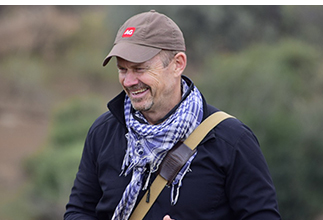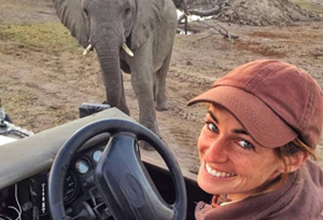
This is a copy of our weekly email newsletter. Subscribe here to receive the newsletter.
Forest whisperers + elusive aardvarks + photographic safaris

So yesterday, I was cycling the hills above the sleepy smallholder haven that is the Crags in South Africa’s Garden Route. Lizz and I unplug here for two weeks every year. A few hours into yesterday’s meander, I met up with two locals who showed me some of their favourite forest tracks. One, a retired gent, has purchased a few smallholdings and is on a mission to force nut farming to work in an area too humid for that particular agricultural pursuit. He told me about his mission to remove that ‘scrappy bush’ (including the diverse, unique, celebrated fynbos) and replace it with regimented rows of nut trees that require intense chemical treatment and high electrified fences to prevent pilfering by humans and wildlife. A fortressed green desert. He is not a farmer and does not need to earn a living anymore, having sold his business. He just wanted something to do. The trophy nut farm is a thing amongst wealthy retired people, apparently. There goes the neighbourhood …
Meanwhile, in the bushveld town of Hoedspruit bordering the Greater Kruger, our passionate teamAG is enduring sweltering early summer temperatures – but the rain has yet to make an appearance. This is PRIME safari time – if you can stand the heat. The bushveld is cork-dry, although some of the larger trees have shed their annual flower cover for the bright green of new leaves. Eyes cast heavenward, local inhabitants await the glorious first rains …
Keep the passion

Simon Espley – CEO, Africa Geographic
 TRAVEL DESK UPDATES:
TRAVEL DESK UPDATES:
We have two thrilling safaris lined up for photographic enthusiasts next year, offering up-close wildlife action and adventure. Start the discussion with us now!
Chitake Springs photographic and walking safari – 6 days:
This short, epic safari, led by two expert guides, is for the daring traveller and photographer seeking the ultimate in-your-face wildlife drama. Chitake Springs in Mana Pools National Park is a growing talking point amongst photographic guides for producing raw, untamed wildlife action. There are only 5 spots left for this safari, departing in September 2023.
Join us for this spectacular photographer-guided safari in the Maasai Mara. A specially modified photographer’s vehicle, off-road driving permits and the renowned big cats and Wildebeest Migration are a recipe for adventure. Join us next year in June, or August (only 2 spots left), for a once-in-a-lifetime trip.
From our Editor – Taryn van Jaarsveld

At AG, we believe that cultural heritage and indigenous knowledge are powerful conservation tools.
A few weeks ago, Simon travelled to magical Arabuko-Sokoke Forest and Mida Creek on Kenya’s tropical coast, where he spent time with A Rocha Kenya – a highly effective programme using ecotourism to fund community programmes and the restoration of threatened forests. Read Simon’s inspiring account of how impactful travel can empower rural communities and boost conservation in Africa below.
If you’ve ever come across a cavernous, freshly dug hole while out walking in the African bushveld, you’ve discovered that most fantastical of features: an aardvark lair. I’ve had the pleasure of finding dozens of these dwellings while hiking grasslands, mountains and bushveld areas throughout Africa – even in nature reserves in Greater Johannesburg. But I’ve never had the fortune of seeing an aardvark in the flesh. Spotting the elusive aardvark is high up on my bucket list. Read about this keystone species and shaper of landscapes in our second story below.
Happy celebrating Africa to you all!

Story 1
https://africageographic.com/stories/forest-whisperers/
FOREST WHISPERERS
Simon set out to Arabuko-Sokoke Forest and Mida Creek in Kenya to find out how community members are restoring threatened forests
Story 2
https://africageographic.com/stories/aarvark-the-earth-pig-of-africa/
EARTH PIG
The elusive aardvark is a keystone species, shaping the landscape around it and providing dwellings for other mammals, reptiles and birds
From our Scientific Editor – Jamie Paterson

We all have moments when even our native tongue fails us, and we forget a word we’ve known all our lives. Take my friend, for example, who, in a recent discussion about elephant drinking habits, referred to “elephant straws”. The word she was looking for was, of course, “trunk”, but her moment of amnesia inspired this newsletter fact-of-the-week.
Did you know that elephants suck water into their trunks at a speed of around 500 km/hour? One solid slurp will pull in three litres of water in a second. In the process, their nostrils expand in volume by 64%. However, the author was quick to emphasise that trunks are not “straws”.

 WATCH: African Voices for Africa’s Forests | All across Africa, communities are pushing back against extractive industries and corporations grabbing their resources and land, by honouring indigenous methods of preserving nature and biodiversity. This short film highlights how communities are exploring nature-based solutions and climate justice to combat deforestation in Cameroon (09:01). Click here to watch
WATCH: African Voices for Africa’s Forests | All across Africa, communities are pushing back against extractive industries and corporations grabbing their resources and land, by honouring indigenous methods of preserving nature and biodiversity. This short film highlights how communities are exploring nature-based solutions and climate justice to combat deforestation in Cameroon (09:01). Click here to watch
To comment on this story: Login (or sign up) to our app here - it's a troll-free safe place 🙂.![]()






